Unity动画文件优化探究
- 作者:admin
- /
- 时间:2017年06月28日
- /
- 浏览:25059 次
- /
- 分类:厚积薄发
为了优化Unity动画文件,作者从两个角度出发:1)压缩浮点数精度和 2)去除scale曲线,通过多次实验观察,得出了通过精度优化降低内存的本质,文末附工具代码和使用说明,值得大家探究和借鉴。
前不久笔者在UWA群里和一些朋友们讨论动画文件精度优化的问题,参考了UWA问答上王亮的代码后,我也尝试优化了动画文件,发现如下的一个很奇怪的现象。下图中Inspector中显示的大小并没有任何变化,但是文件大小和Profiler中的内存大小确实是减小了。那么Inspector中显示的Size是什么含义呢?
下图中的动画文件不包含Scale曲线,所以这次优化中只压缩了浮点数精度。
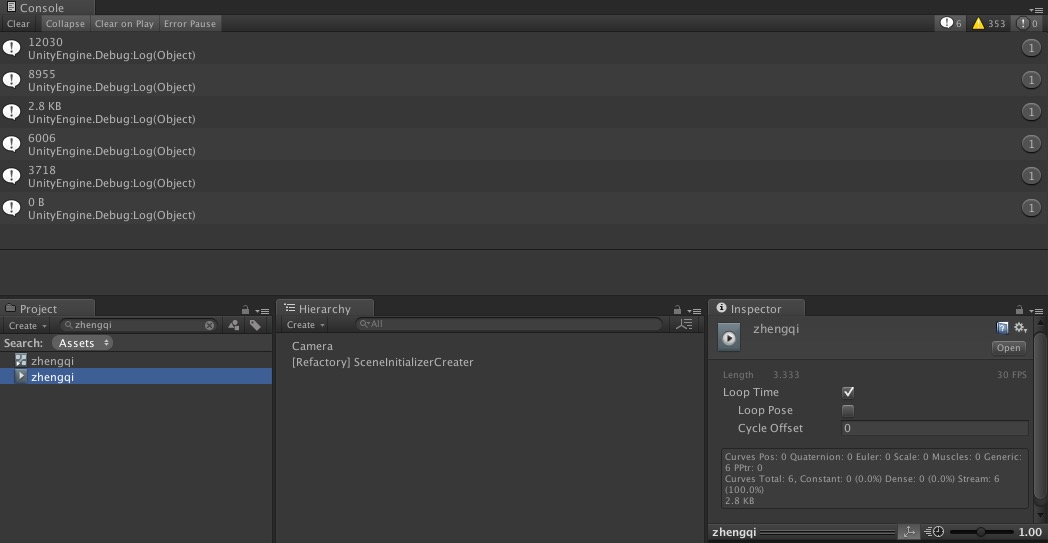
我分别对比了动画文件优化前和优化后的大小。
FileSize
- FileInfo.Length取得的文件大小
- 可以在操作系统的文件系统中看到
MemorySize
- Profiler.GetRuntimeMemorySize取得的内存大小
- 可以在Profiler中通过采样看到
- 分别在真机和Editor下进行了采样
BlobSize
- 反射取得的AnimationClipStats.size二进制大小
- 显示在AnimationClip的Inspector的面板上

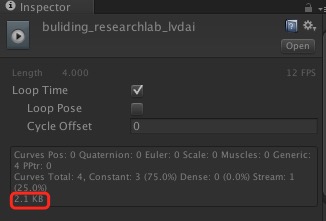
红色框内即是BlobSize,在我的理解,FileSize是指文件在硬盘中占的大小,BlobSize是从文件反序列化出来的对象的二进制大小。Editor下的MemorySize不仅有序列化后的内存大小,还维护了一份原文件的内存。就像我们在Editor下加载一张Texture内存是双份一样,而真机下就约等于BlobSize。真机下的MemorySize和Inspector里的BlobSize非常接近,BlobSize可以认为是真机上的内存大小,这个大小更有参考意义。
同时,我也对去除Scale曲线的方法进行了实验。下图这个动画文件原来Inspector中Scale的值为4,即有Scale曲线,原始文件BlobSize为10.2KB,去除Scale曲线后,Blob Size变为7.4KB,所以BlobSize减小了27%。
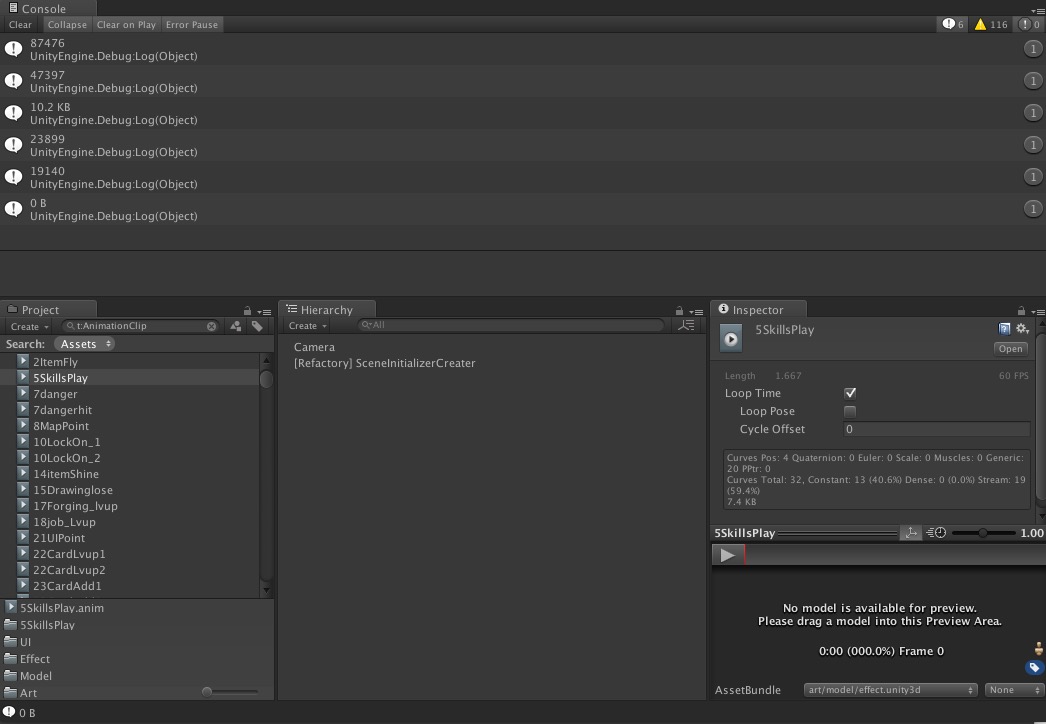

Curve减少导致内存减小
从上面的实验可以看出来,只裁剪动画文件的压缩精度,没有引起Curve减少。BlobSize是不会有任何变化的,因为每个浮点数固定占32bit。而文件大小、AB大小、Editor下的内存大小,压缩精度后不管有没有引起Curve的变化,都会变小。
裁剪动画文件的精度,意味着点的位置发生了变化,所以Constant Curve和Dense Curve的数量也有可能发生变化。由于是裁剪精度所以动画的点更稀疏了,而连续相同的点更多了。所以Dense Curve是减少了,Constant Curve是增多了,总的内存是减小了。
Constant Curve只需要最左边的点就可以描述一个曲线段。
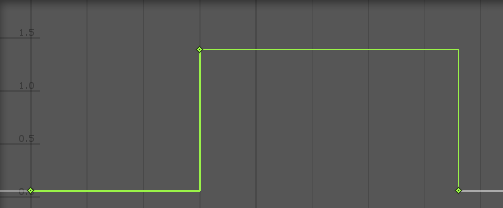
只裁剪精度使BlobSize减小的实例
裁剪精度前,大小为2.2kb,ScaleCurve为0, ConstantCurve为4(57.1%),Stream(使用Optimal模式这部分数据将储存为Dense)为3(42.9%)。

裁剪精度后,大小为2.1kb,ConstantCurve为7(100%),Stream为0(0%)。裁剪完精度后导致ConstantCurve增加了3,Stream(Optimal模式下即为Dense)减少了3,BlobSize减小了0.1kb。

因此,可以看出,通过精度优化降低内存的方式,其实质是将曲线上过于接近的数值(例如相差数值出现在小数点4位以后)直接变为一致,从而使部分曲线变为constant曲线来降低内存消耗。
总结
隔壁项目组对他们项目中所有的动画文件都进行了优化。其中文件大小从820MB->225MB, ab大小从72MB->64MB, 内存大小从50MB->40MB。总的来说动画文件的scale越多优化越明显。
取BlobSize代码
AnimationClip aniClip = AssetDatabase.LoadAssetAtPath<AnimationClip> (path);
var fileInfo = new System.IO.FileInfo(path);
Debug.Log(fileInfo.Length);//FileSize
Debug.Log(Profiler.GetRuntimeMemorySize (aniClip));//MemorySize
Assembly asm = Assembly.GetAssembly(typeof(Editor));
MethodInfo getAnimationClipStats = typeof(AnimationUtility).GetMethod("GetAnimationClipStats", BindingFlags.Static | BindingFlags.NonPublic);
Type aniclipstats = asm.GetType("UnityEditor.AnimationClipStats");
FieldInfo sizeInfo = aniclipstats.GetField ("size", BindingFlags.Public | BindingFlags.Instance);
var stats = getAnimationClipStats.Invoke(null, new object[]{aniClip});
Debug.Log(EditorUtility.FormatBytes((int)sizeInfo.GetValue(stats)));//BlobSize
工具代码
最后附上工具的代码和简要使用说明,选中想要优化的文件夹或文件,右键Animation->裁剪浮点数去除Scale。
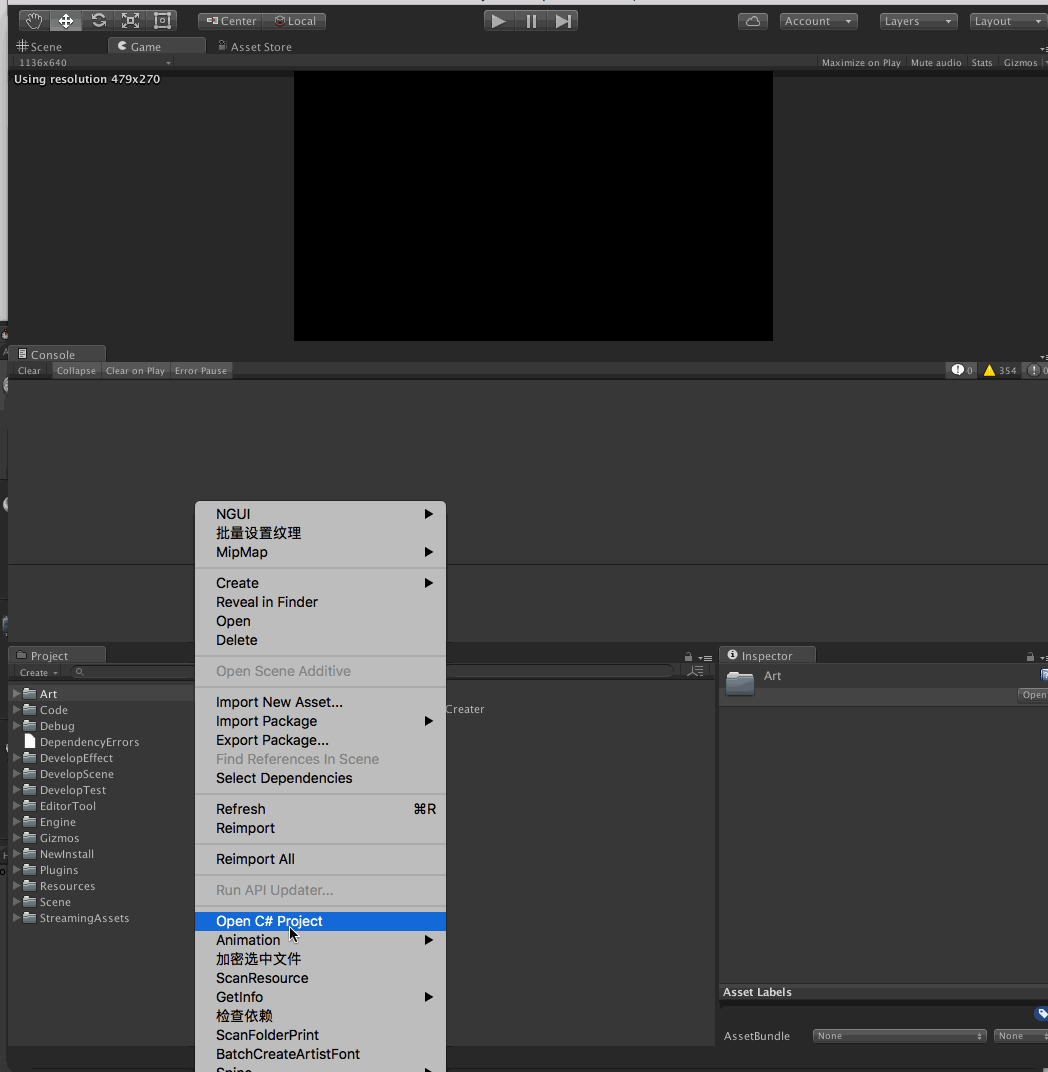
//****************************************************************************
//
// File: OptimizeAnimationClipTool.cs
//
// Copyright (c) SuiJiaBin
//
// THIS CODE AND INFORMATION IS PROVIDED "AS IS" WITHOUT WARRANTY OF
// ANY KIND, EITHER EXPRESSED OR IMPLIED, INCLUDING BUT NOT LIMITED TO
// THE IMPLIED WARRANTIES OF MERCHANTABILITY AND/OR FITNESS FOR A
// PARTICULAR PURPOSE.
//
//****************************************************************************
using System;
using System.Collections.Generic;
using UnityEngine;
using System.Reflection;
using UnityEditor;
using System.IO;
namespace EditorTool
{
class AnimationOpt
{
static Dictionary<uint,string> _FLOAT_FORMAT;
static MethodInfo getAnimationClipStats;
static FieldInfo sizeInfo;
static object[] _param = new object[1];
static AnimationOpt ()
{
_FLOAT_FORMAT = new Dictionary<uint, string> ();
for (uint i = 1; i < 6; i++) {
_FLOAT_FORMAT.Add (i, "f" + i.ToString ());
}
Assembly asm = Assembly.GetAssembly (typeof(Editor));
getAnimationClipStats = typeof(AnimationUtility).GetMethod ("GetAnimationClipStats", BindingFlags.Static | BindingFlags.NonPublic);
Type aniclipstats = asm.GetType ("UnityEditor.AnimationClipStats");
sizeInfo = aniclipstats.GetField ("size", BindingFlags.Public | BindingFlags.Instance);
}
AnimationClip _clip;
string _path;
public string path { get{ return _path;} }
public long originFileSize { get; private set; }
public int originMemorySize { get; private set; }
public int originInspectorSize { get; private set; }
public long optFileSize { get; private set; }
public int optMemorySize { get; private set; }
public int optInspectorSize { get; private set; }
public AnimationOpt (string path, AnimationClip clip)
{
_path = path;
_clip = clip;
_GetOriginSize ();
}
void _GetOriginSize ()
{
originFileSize = _GetFileZie ();
originMemorySize = _GetMemSize ();
originInspectorSize = _GetInspectorSize ();
}
void _GetOptSize ()
{
optFileSize = _GetFileZie ();
optMemorySize = _GetMemSize ();
optInspectorSize = _GetInspectorSize ();
}
long _GetFileZie ()
{
FileInfo fi = new FileInfo (_path);
return fi.Length;
}
int _GetMemSize ()
{
return Profiler.GetRuntimeMemorySize (_clip);
}
int _GetInspectorSize ()
{
_param [0] = _clip;
var stats = getAnimationClipStats.Invoke (null, _param);
return (int)sizeInfo.GetValue (stats);
}
void _OptmizeAnimationScaleCurve ()
{
if (_clip != null) {
//去除scale曲线
foreach (EditorCurveBinding theCurveBinding in AnimationUtility.GetCurveBindings(_clip)) {
string name = theCurveBinding.propertyName.ToLower ();
if (name.Contains ("scale")) {
AnimationUtility.SetEditorCurve (_clip, theCurveBinding, null);
Debug.LogFormat ("关闭{0}的scale curve", _clip.name);
}
}
}
}
void _OptmizeAnimationFloat_X (uint x)
{
if (_clip != null && x > 0) {
//浮点数精度压缩到f3
AnimationClipCurveData[] curves = null;
curves = AnimationUtility.GetAllCurves (_clip);
Keyframe key;
Keyframe[] keyFrames;
string floatFormat;
if (_FLOAT_FORMAT.TryGetValue (x, out floatFormat)) {
if (curves != null && curves.Length > 0) {
for (int ii = 0; ii < curves.Length; ++ii) {
AnimationClipCurveData curveDate = curves [ii];
if (curveDate.curve == null || curveDate.curve.keys == null) {
//Debug.LogWarning(string.Format("AnimationClipCurveData {0} don't have curve; Animation name {1} ", curveDate, animationPath));
continue;
}
keyFrames = curveDate.curve.keys;
for (int i = 0; i < keyFrames.Length; i++) {
key = keyFrames [i];
key.value = float.Parse (key.value.ToString (floatFormat));
key.inTangent = float.Parse (key.inTangent.ToString (floatFormat));
key.outTangent = float.Parse (key.outTangent.ToString (floatFormat));
keyFrames [i] = key;
}
curveDate.curve.keys = keyFrames;
_clip.SetCurve (curveDate.path, curveDate.type, curveDate.propertyName, curveDate.curve);
}
}
} else {
Debug.LogErrorFormat ("目前不支持{0}位浮点", x);
}
}
}
public void Optimize (bool scaleOpt, uint floatSize)
{
if (scaleOpt) {
_OptmizeAnimationScaleCurve ();
}
_OptmizeAnimationFloat_X (floatSize);
_GetOptSize ();
}
public void Optimize_Scale_Float3 ()
{
Optimize (true, 3);
}
public void LogOrigin ()
{
_logSize (originFileSize, originMemorySize, originInspectorSize);
}
public void LogOpt ()
{
_logSize (optFileSize, optMemorySize, optInspectorSize);
}
public void LogDelta ()
{
}
void _logSize (long fileSize, int memSize, int inspectorSize)
{
Debug.LogFormat ("{0} \nSize=[ {1} ]", _path, string.Format ("FSize={0} ; Mem->{1} ; inspector->{2}",
EditorUtility.FormatBytes (fileSize), EditorUtility.FormatBytes (memSize), EditorUtility.FormatBytes (inspectorSize)));
}
}
public class OptimizeAnimationClipTool
{
static List<AnimationOpt> _AnimOptList = new List<AnimationOpt> ();
static List<string> _Errors = new List<string>();
static int _Index = 0;
[MenuItem("Assets/Animation/裁剪浮点数去除Scale")]
public static void Optimize()
{
_AnimOptList = FindAnims ();
if (_AnimOptList.Count > 0)
{
_Index = 0;
_Errors.Clear ();
EditorApplication.update = ScanAnimationClip;
}
}
private static void ScanAnimationClip()
{
AnimationOpt _AnimOpt = _AnimOptList[_Index];
bool isCancel = EditorUtility.DisplayCancelableProgressBar("优化AnimationClip", _AnimOpt.path, (float)_Index / (float)_AnimOptList.Count);
_AnimOpt.Optimize_Scale_Float3();
_Index++;
if (isCancel || _Index >= _AnimOptList.Count)
{
EditorUtility.ClearProgressBar();
Debug.Log(string.Format("--优化完成-- 错误数量: {0} 总数量: {1}/{2} 错误信息↓:\n{3}\n----------输出完毕----------", _Errors.Count, _Index, _AnimOptList.Count, string.Join(string.Empty, _Errors.ToArray())));
Resources.UnloadUnusedAssets();
GC.Collect();
AssetDatabase.SaveAssets();
EditorApplication.update = null;
_AnimOptList.Clear();
_cachedOpts.Clear ();
_Index = 0;
}
}
static Dictionary<string,AnimationOpt> _cachedOpts = new Dictionary<string, AnimationOpt> ();
static AnimationOpt _GetNewAOpt (string path)
{
AnimationOpt opt = null;
if (!_cachedOpts.ContainsKey(path)) {
AnimationClip clip = AssetDatabase.LoadAssetAtPath<AnimationClip> (path);
if (clip != null) {
opt = new AnimationOpt (path, clip);
_cachedOpts [path] = opt;
}
}
return opt;
}
static List<AnimationOpt> FindAnims()
{
string[] guids = null;
List<string> path = new List<string>();
List<AnimationOpt> assets = new List<AnimationOpt> ();
UnityEngine.Object[] objs = Selection.GetFiltered(typeof(object), SelectionMode.Assets);
if (objs.Length > 0)
{
for(int i = 0; i < objs.Length; i++)
{
if (objs [i].GetType () == typeof(AnimationClip))
{
string p = AssetDatabase.GetAssetPath (objs [i]);
AnimationOpt animopt = _GetNewAOpt (p);
if (animopt != null)
assets.Add (animopt);
}
else
path.Add(AssetDatabase.GetAssetPath (objs [i]));
}
if(path.Count > 0)
guids = AssetDatabase.FindAssets (string.Format ("t:{0}", typeof(AnimationClip).ToString().Replace("UnityEngine.", "")), path.ToArray());
else
guids = new string[]{};
}
for(int i = 0; i < guids.Length; i++)
{
string assetPath = AssetDatabase.GUIDToAssetPath (guids [i]);
AnimationOpt animopt = _GetNewAOpt (assetPath);
if (animopt != null)
assets.Add (animopt);
}
return assets;
}
}
}
这是侑虎科技第246篇原创文章,感谢作者舒航供稿,欢迎转发分享,未经作者授权请勿转载。当然,如果您有任何独到的见解或者发现也欢迎联系我们,一起探讨。(QQ群:793972859)
作者博客:http://www.codershu.com. 同时,作者也是U Sparkle活动参与者哦,UWA欢迎更多开发朋友加入U Sparkle开发者计划,这个舞台有你更精彩!





